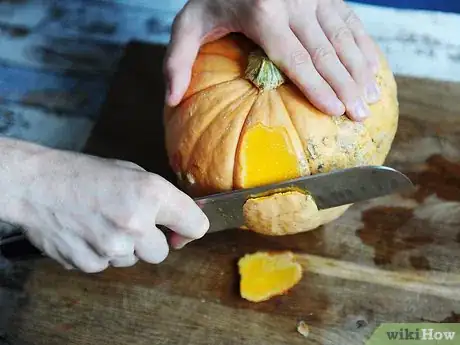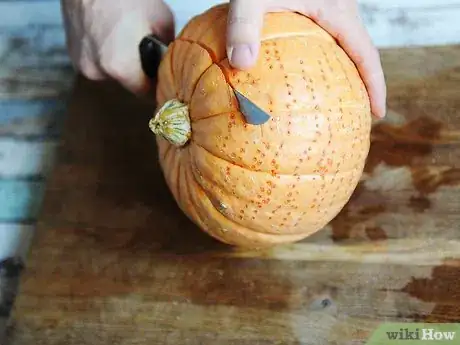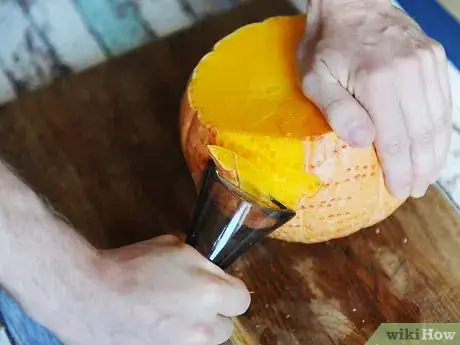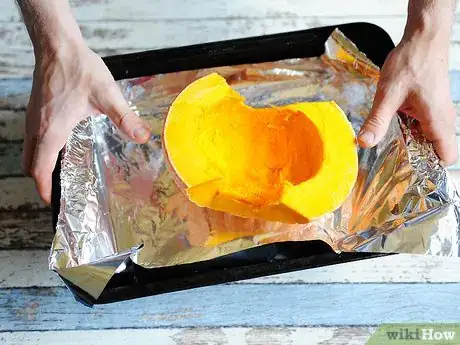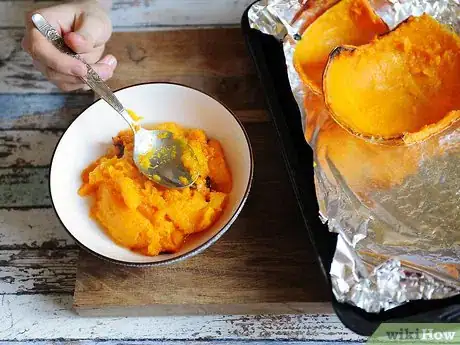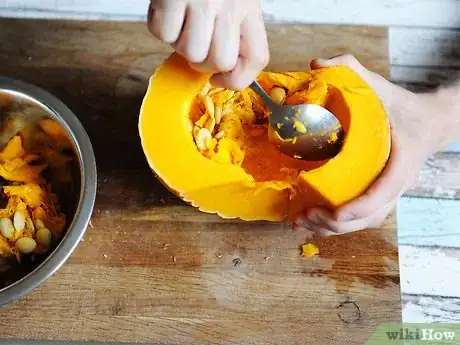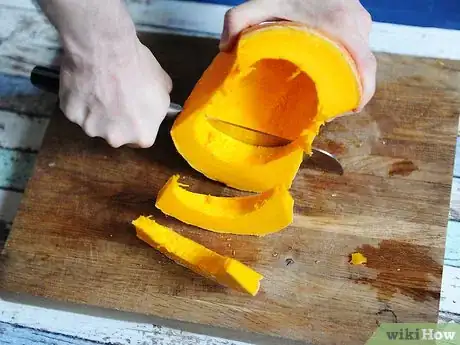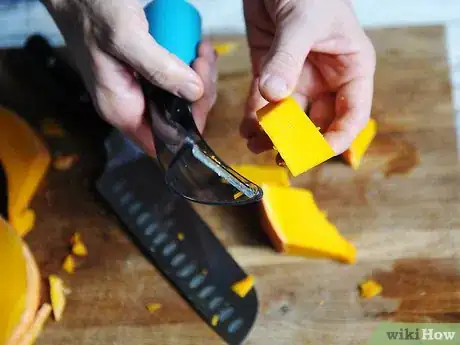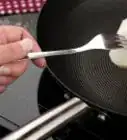This article was co-authored by Marrow Private Chefs. Marrow Private Chefs are based in Santa Rosa Beach, Florida. It is a chefs’ collaborative comprised of an ever-growing number of chefs and culinary professionals. Though regionally influenced primarily by coastal, traditional southern, cajun, and creole styles and flavors, the chefs at Marrow have a solid background in all types of cuisine with over 75 years of combined cooking experience.
There are 8 references cited in this article, which can be found at the bottom of the page.
This article has been viewed 26,779 times.
Given the thick, ridged skin of an acorn squash, the prospect of peeling this particular squash is not all that inviting. However, there are several ways to tackle peeling that stubborn acorn squash. From boiling, microwaving, roasting, or chopping, pick the method best suited for you! Regardless of how you plan to peel it, just make sure to start by giving the acorn squash a good rinse under cool water and to dry it off completely afterwards.[1]
Steps
Boiling an Acorn Squash
-
1Place the acorn squash into a pot of boiling water for 15 minutes. Boiling the squash will help soften the skin and make the removal process easier. Boiling the squash is ideal for people who are not fully comfortable with using a sharp knife or a serrated peeler.[2]
- Like with most boiled vegetables, boiling the squash can alter the texture and reduce the flavor within the squash.
-
2Pour off the hot water, and allow the squash to rest. You can place the squash in cold water for 5 minutes to speed up the process or wait until the squash is cool enough to handle. Just make sure to fully dry off the squash before proceeding to cut away the peel.[3]Advertisement
-
3Use a knife or a serrated peeler to slice off the softened skin. It is best to start with the raised ridges and then move to the valleys of the squash. Once completely peeled, you can then cut off the stem, slice in half, and gut the acorn squash as needed for your recipe.[4]
- To remove particularly stubborn skin within the valleys, you can use a sturdy spoon to dig out the peel.
Microwaving to Remove the Skin Quickly
-
1Use a fork to poke holes through the skin of the squash. Making holes around the entirety of the squash will allow the squash to breathe in the microwave and soften properly.[5]
-
2Microwave the squash on high for approximately 2 to 4 minutes. Depending on the size, increase the time length in 1-minute intervals. The microwave will help soften the skin and make the removal process easier.[6]
- Microwaving the squash works particularly well for people who want to save time, and for people who are not fully comfortable using a sharp knife or a serrated peeler.
- It is important to know that the microwave can decrease the texture and flavor of the squash.
-
3Remove the squash from the microwave. Allow the squash to rest for 1 to 2 minutes, or until it is cool enough to handle. The skin should feel considerably softer.[7]
-
4Use a heavy knife to cut off the stem and bottom end of the squash. This will create a flat surface area along the squash for you to work from.
-
5Peel the raised ridges and then the valleys with a serrated peeler.Work from the top to the bottom of the squash. If you have a large squash, then peel the top half, and then flip it over and peel the second half. Once peeled, you can slice or cut the squash as needed for your recipe.[8]
Roasting Squash
-
1Use a heavy knife to cut off the stem and the bottom of the squash. This will create a flat surface for you to easily work with. Then carefully cut the squash in half, starting at the top and working your way downwards.[9]
-
2Clean out the cavity. Using a metal spoon, scoop out the seeds and fibers until it is hollowed. The seeds are edible; so much like pumpkin seeds, you can season and toast them in the oven.[10]
-
3Roast the squash in the oven cut-side down at 400 °F (204 °C) for 1 hour. The cooking time does depend on the size of the squash, but when done, the squash should be tender when prodded with a fork.[11]
- Make sure to grease the baking sheet so the squash does not stick.
-
4Remove the squash from the oven and let rest until it is cool to touch. The squash might take 5 to 10 minutes to cool, so be patient. Do not place in the fridge to speed up the cooling process because it might harden the softened pulp.
-
5Take a metal spoon and scoop the desired pulp from the skin. Roasting the squash is particularly great if you only require the cooked pulp for your recipe, but not ideal if you desire chunks or slices of the squash.[12]
Peeling an Acorn Squash without Heat
-
1Take a heavy knife and cut off the stem and the base of the squash. Removing the rounded ends creates a sturdy base for you to work around. If the ends are not level or completely flat after your first cut, don’t be afraid to cut off a little more to even it out.[13]
-
2Cut the squash in half lengthwise, top to bottom. Make sure you use a heavy knife and have a firm grip on the squash to avoid slipping. The flattened surface you created should keep the squash from wobbling too much during this process.[14]
-
3Use a metal spoon to scoop out the seeds and stringy fibers. Much like pumpkin seeds, acorn squash seeds are edible and toast just the same. So if you are feeling adventurous, save the seeds to bake up later![15]
-
4Cut along the valleys of the halved squash for smaller slices. The valleys should act as guidelines for this process.[16]
- Instead of slices, you can also cut the halved squash into quarter dices, and then use a sharp knife to cut away the skin on each dice.
-
5Peel each slice lengthwise with a serrated peeler. Due to the ridge along the skin, the slice will most likely be triangular shaped. So some of the slices might require you to peel the ridge first, and others might not, depending on how prominent the ridge is.[17]
Expert Interview
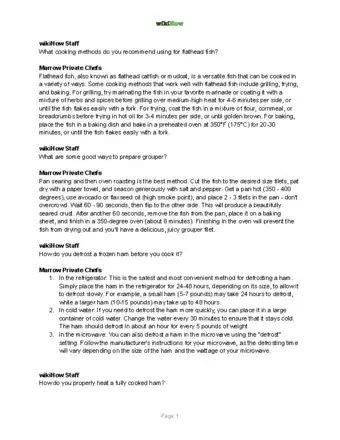
Thanks for reading our article! If you'd like to learn more about peeling an acorn squash, check out our in-depth interview with Marrow Private Chefs.
References
- ↑ https://www.rachelcooks.com/2017/09/27/how-to-cook-acorn-squash/
- ↑ https://www.tasteofhome.com/cooking-tips/vegetables/how-to-peel-acorn-squash
- ↑ https://www.tasteofhome.com/cooking-tips/vegetables/how-to-peel-acorn-squash
- ↑ https://www.tasteofhome.com/cooking-tips/vegetables/how-to-peel-acorn-squash
- ↑ https://www.skinnytaste.com/easy-tip-for-cutting-and-peeling-winter/
- ↑ https://www.skinnytaste.com/easy-tip-for-cutting-and-peeling-winter/
- ↑ https://www.chatelaine.com/food/kitchen-tips/an-easy-way-to-cut-butternut-squash/
- ↑ https://www.skinnytaste.com/easy-tip-for-cutting-and-peeling-winter/
- ↑ https://www.simplyrecipes.com/recipes/classic_baked_acorn_squash/
- ↑ https://www.simplyrecipes.com/recipes/classic_baked_acorn_squash/
- ↑ https://www.simplyrecipes.com/recipes/classic_baked_acorn_squash/
- ↑ https://www.simplyrecipes.com/recipes/classic_baked_acorn_squash/
- ↑ https://www.bonappetit.com/test-kitchen/how-to/article/how-to-cut-acorn-squash
- ↑ https://www.bonappetit.com/test-kitchen/how-to/article/how-to-cut-acorn-squash
- ↑ https://www.simplyrecipes.com/recipes/classic_baked_acorn_squash/
- ↑ https://lazyhomesteader.com/2011/10/11/how-to-peel-an-acorn-squash/
- ↑ https://lazyhomesteader.com/2011/10/11/how-to-peel-an-acorn-squash/
- ↑ https://www.epicurious.com/expert-advice/peel-winter-squash-skins-article
- ↑ https://www.epicurious.com/expert-advice/peel-winter-squash-skins-article


